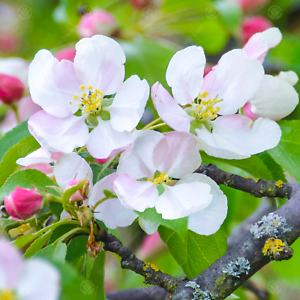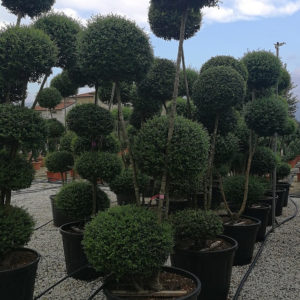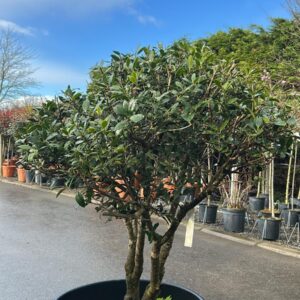Malus ‘Red Sentinel’ / Crab Apple
Price range: €150.00 through €520.00
Frequently Bought Together
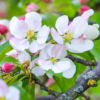
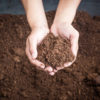
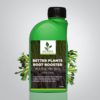
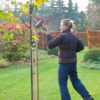
Description
Quick Facts
- Common Name: Red Sentinel Crab Apple, Red Sentinel Crabapple
- Botanical Name: Malus ‘Red Sentinel’
- Plant Type: Deciduous tree
- Mature Height: 5-7m
- Mature Spread: 4-5m
- Flowering Period: April to May
- Flower Colour: White flowers from pink buds
- Foliage: Ovate leaves, mid-green turning yellow in autumn
- Hardiness: RHS H7 (very hardy)
- Soil Requirements: Moist, well-drained, fertile
- Aspect: Full sun to partial shade
- Maintenance: Low to moderate
Description
Experience the spectacular beauty of Malus ‘Red Sentinel’, the outstanding Crab Apple that brings exceptional multi-season interest, abundant wildlife value, and stunning winter colour to Irish gardens with its profuse white blossom and remarkable persistent red fruits. This exceptional ornamental tree offers year-round benefits—masses of beautiful white flowers opening from pink buds in spring that smother the branches in delicate blossom and attract countless pollinators, abundant crops of glossy bright red fruits measuring 2.5cm across that develop in late summer and persist well into winter, often remaining on the tree until February or even March providing spectacular colour when little else offers interest, exceptional wildlife value with fruits providing vital winter food for thrushes, blackbirds, and other birds, and attractive mid-green foliage that turns warm yellow tones in autumn, making this one of the finest and most reliable crab apples for creating four-season interest, wildlife habitat, and winter drama in your garden.
Throughout spring, this captivating tree becomes completely covered in masses of beautiful white flowers measuring 3-4cm across, opening from pretty pink-tinged buds and creating a spectacular display of pure white blossom that rivals ornamental cherries. The flowers appear in generous clusters along the branches, creating a stunning cloud of white that attracts bees, butterflies, and other pollinators. The mid-green ovate leaves measuring 5-8cm long with serrated edges emerge as the flowers fade, creating attractive fresh foliage throughout summer. By late summer and autumn, the tree becomes adorned with abundant clusters of glossy bright red fruits (crab apples) measuring approximately 2.5cm diameter—larger than many crab apple varieties. These spectacular fruits are the tree’s crowning glory, persisting on the branches long after the leaves have fallen, often remaining until late winter or early spring, providing outstanding colour and structure when the garden is at its quietest. The fruits glow like jewels against winter skies and provide essential food for birds during harsh weather.
This remarkable cultivar was raised in the UK and has received the RHS Award of Garden Merit for its outstanding ornamental qualities and reliable performance. The name ‘Red Sentinel’ perfectly describes the bright red fruits that stand guard on the branches throughout winter like vigilant sentries. Exceptionally hardy and adaptable, this crab apple thrives in Irish conditions, tolerating exposure, urban pollution, and a wide range of soil types. One of the best crab apples for fruit persistence—the fruits remain decorative far longer than most varieties, often lasting until birds finally strip them in late winter. Compact size makes this suitable for medium to large gardens.
Create stunning compositions by planting as spectacular specimen trees in lawns where the spring blossom and winter fruits can be fully appreciated. Magnificent in mixed borders, cottage gardens, or wildlife gardens where the abundant fruits provide essential food for birds. Works beautifully in small orchards or edible gardens—the fruits can be used for making excellent crab apple jelly, though most gardeners prefer to leave them for the birds. Exceptional underplanted with spring bulbs like white and blue muscari or daffodils that complement the white blossom. Plant where visible from the house to enjoy the spectacular winter fruit display, particularly stunning when frost-covered or backlit by low winter sun.
Caragh Garden Notebook
Planting: Space trees 5-6m apart for groupings, or allow 6-7m for specimen placement. Plant bare-root trees from November to March, or container-grown specimens year-round (autumn or early spring is ideal). Dig holes twice the width of the root ball and incorporate generous amounts of organic matter. Plant at the same depth as the nursery soil mark. Stake securely for the first 2-3 years. Water thoroughly and mulch around the base, keeping mulch away from the trunk.
Soil Preparation: Thrives in moist, well-drained, fertile soil with pH 6.0-7.0. Prefers neutral to slightly acidic, moisture-retentive conditions enriched with organic matter. Tolerates moderately acidic to slightly alkaline soils and adapts to clay or loam. Dislikes waterlogged, very dry, or shallow chalky soils. Best flowering, fruiting, and overall growth occur in full sun with consistent moisture, good drainage, and shelter from harsh winds. Tolerates partial shade but produces fewer flowers and fruits.
Container Growing: Young specimens can be grown in very large containers (minimum 70cm diameter) using soil-based compost for several years, creating attractive patio features. Water regularly and feed in spring with slow-release balanced fertiliser. However, for best long-term health, abundant flowering, spectacular fruit production, and characteristic form, plant out into the ground where the root system can develop fully.
Seasonal Care: Requires minimal pruning—the naturally rounded form develops without intervention. Remove only dead, damaged, or crossing branches in late winter when dormant. Thin overcrowded branches if needed to improve air circulation and reduce disease risk. Avoid heavy pruning as this removes flowering and fruiting wood. Prune in winter only—never in spring or summer as this increases risk of diseases. Apply slow-release balanced fertiliser in early spring. Mulch annually with organic matter. Water during dry spells, especially in the first 3-5 years until established. Monitor for apple scab, powdery mildew, and aphids—generally disease resistant but may show some scab in wet seasons (this rarely affects overall performance).
Propagation: Cannot be propagated from seed as this is a named cultivar that will not come true from seed. Professional propagation is by grafting onto rootstock (typically M25 or MM106 for full-sized trees). Budding in summer is also used commercially. Home gardeners should purchase nursery-grown grafted specimens for guaranteed quality, reliable abundant fruiting, and characteristic fruit persistence.
This spectacular beauty is absolutely outstanding—those masses of white spring blossom are gorgeous, but the real magic is those abundant glossy red fruits that persist through winter! They glow like jewels against grey winter skies and provide vital food for birds when they need it most. One of the best crab apples for fruit persistence—those fruits often last until February or March! Compact, reliable, and four-season interest at its finest. A true winter sentinel!

